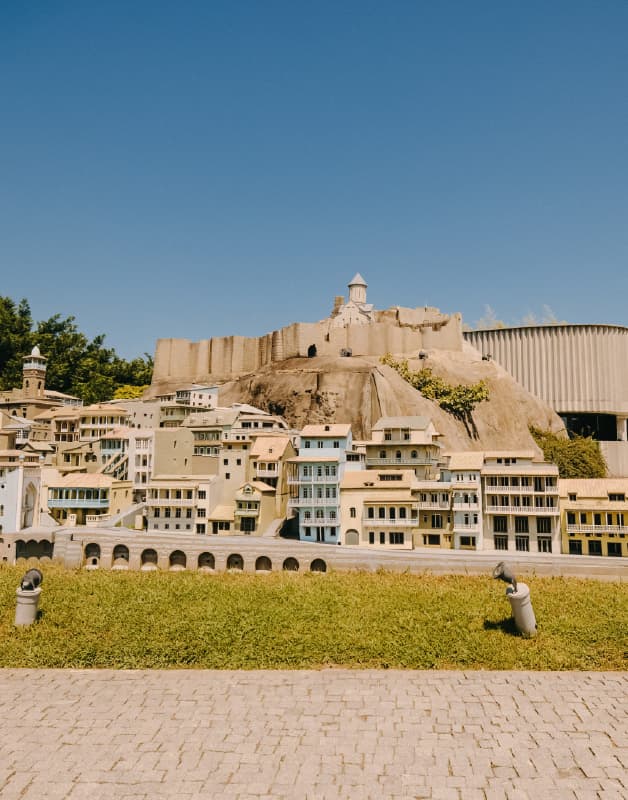Narikala and Abanotubani

Narikala:
Narikala’s construction is estimated to date back to the 4th century. Since then, the fortress has gradually changed in form and function, making it one of the oldest and most vibrant architectural symbols of Tbilisi. It was a defensive structure with a complex system, fortified with strong walls, towers, and bastions - difficult to access and conquer.
Abanotubani:
Tbilisi’s oldest district, located on the right bank of the Mtkvari River. Its name is associated with the famous sulfur baths built over natural hot mineral springs.
Narikala:
According to one version, in the 4th century, King Varaz-Bakur built the fortress on this site, which was later taken over by the Sassanid Empire of Persia. In the mid-5th century, the kings of Kartli reclaimed the fortress. It was significantly expanded in the 7th century, and later again in the 12th century under King David the Builder. The fortress has been destroyed and rebuilt many times.
Did you know that...
1. Narikala had several names, including “Kala,” “Shuris Tsikhe” (Fortress of Envy), and “Narin Qala.” The latter, meaning "citadel" in Persian, is the source of the current name.
2. According to legend, the fortress—like the city of Tbilisi itself—was founded by King Vakhtang Gorgasali.
3. The main surviving fortifications date to the 16th and 17th centuries. A major earthquake in 1827 damaged and destroyed much of the fortress walls.
4. Remains of the earlier construction can still be seen in the form of hewn stone in the walls of the northeastern tower.
5. Until the 17th century, a royal palace was located inside the fortress near the entrance tunnel. After the Kingdom of Kartli-Kakheti was annexed by the Russian Empire in 1801, the citadel lost its former significance. It is believed that a Russian army ammunition depot was later placed there, which exploded in 1847 after being struck by lightning.
Abanotubani:
The story of Tbilisi’s founding, which is part legend and part history, attributes the discovery of the hot springs and the building of the city to King Vakhtang Gorgasali in the 5th century. The 10th-century Arab geographer Ibn Hawqal wrote: “The city has baths like those in Tiberias, with water that boils without fire.” According to historical sources, in the 13th century there were 65 bathhouses in Tbilisi. Information about the baths is also provided by the Venetian traveler Marco Polo (13th–14th centuries), Russian merchant Vasil Gagara (18th century), and Vakhushti Bagrationi, who counted six baths in Tbilisi.
Did you know that...
1. According to legend, Tbilisi was once covered in forest. One day, King Vakhtang Gorgasali was hunting in the area when his falcon chased a pheasant. The hunters followed and found both birds boiled in a hot spring. The king decided to establish a city on the spot.
2. In the 17th–19th centuries, Tbilisi had many bathhouses such as Erekle’s, Bebuta’s, Meliki’s, Meitri’s (Sumbatov’s), Gogilo’s, Orbeliani’s, Tbilisi’s, Mirzoev’s, Khoja’s, “Grili” (Shioev’s), “Chreli” and others. Most of the surviving bathhouses date back to the 17th–18th centuries and were built under Persian architectural influence. They are concentrated near the base of the Botanical Garden slope, hence the name “Abanotubani” (Bath District).
3. Bathhouses were often named after their owner or their position, and names would change depending on ownership.
4. The old Tbilisi bathhouses served not only hygienic but also social purposes. Ioseb Grishashvili wrote: “In the past, bathhouses were open all night for those who wanted to stay. Sometimes they served as inns for visiting peasants, who would bring their livestock to the courtyard and sleep in the bathhouse after washing, paying only a few coins. Women would spend the whole day there, even dine and drink tea - it was their club and their theater. They would also show off their dresses and jewelry. New outfits were first worn in the bathhouse. Matchmakers were active there too, and many love stories and even discoveries of physical imperfections happened in the baths.”
5. The famous French writer Alexandre Dumas visited the Tbilisi baths in the 1850s. He wrote: “Why is it that a city as full of emotion as Paris has nothing like these baths? Why hasn’t any businessman thought to import a couple of bath attendants from Tbilisi? It would be both useful and profitable. During my six-week stay in Tbilisi, I went to the Persian bath every third day.”


